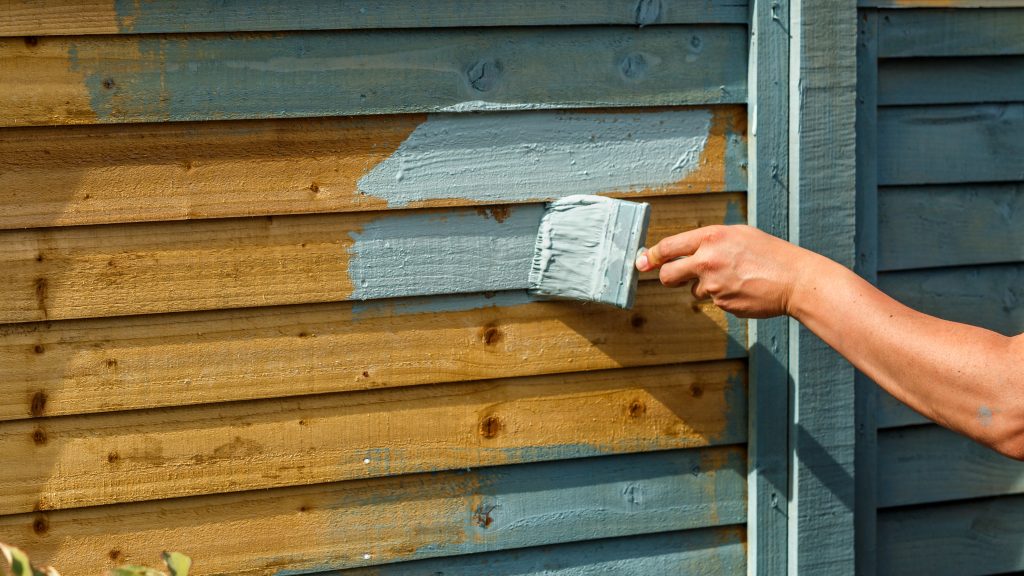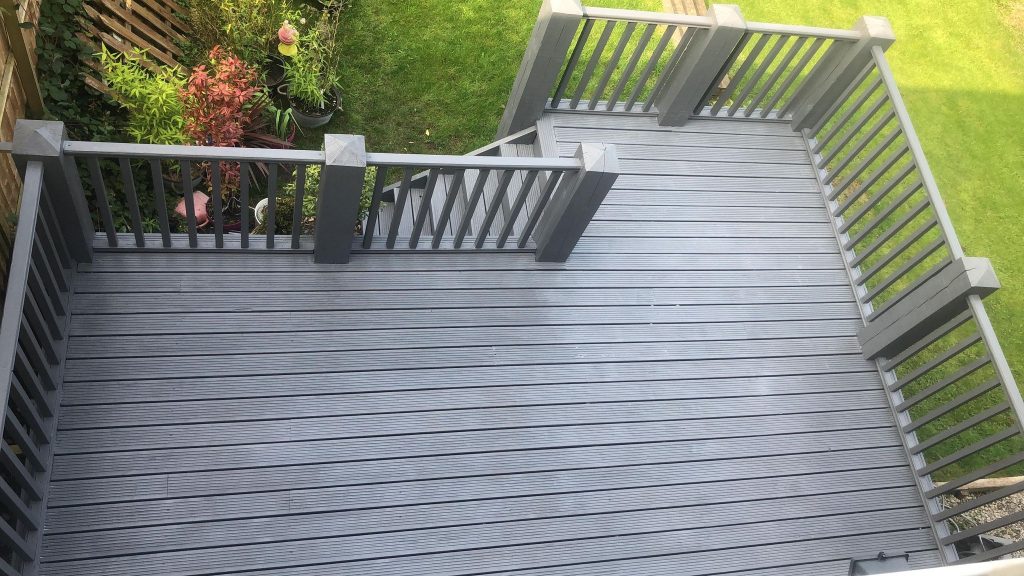
Painting a fence is one of life’s simplest pleasures. Even if you’re not a fan of Tom Sawyer, the act of rollering, spraying or doing it old-school with a paintbrush is a great way to spend a nice afternoon in the garden. But what is the best paint for fences? There are a lot more choices these days than a bucket of whitewash.
We’re here to not only tell you about the best fence paint, but where to buy the best fence paint and how to paint a fence too. Let’s get started.
Key Takeaways
- Oil based fence paint and water-based fence paint are your main choices – but there are alternatives too
- No primer is needed for painting fences
- The colour you choose should match or complement your garden
What is the Best Fence Paint?
For your common or garden wooden fence, you want a type of fence paint that strikes a balance between looking great and lasting for a long time. Our fences go through a lot, even in the sunnier seasons. Wind, rain, frost, and snow; you need the best fence paint that’s hardwearing to save it needing repainting every year or so.
When choosing your best fence paint, there are two main types to consider: water based and oil based fence paint. Both have their own pros and cons, so let’s explore both in detail.

Water-Based Fence Paint
Painting your fence with a water-based paint gives you the best of both worlds. It’s tough, working well alongside a durable primer to protect the wood surface while still allowing it to breathe. It comes in a range of bold colours (we’ll talk more about those later!) which look great for years, but also lets the natural woodgrain shine through. In comparison, the thicker oil-based fence paint and clear varnish can give your fences a waxy or plasticky look even with a single layer, so if you want the natural texture of your wooden fences to shine through, a quality water-based paint is the way to go.
A while back, professional decorators would avoid using water-based paint for fences due to the lack of quality compared to oil-based fence paint. However, nowadays the technology involved in the creation of water-based paint makes it just as tough, meaning it’s trickier for even tradespeople to pick between the two.
ADVANTAGES OF WATER-BASED FENCE PAINT
- Easy to apply & Beginner friendly
- Available in a wide range of colours
- Dries quickly
- Non-yellowing
- Lower VOCs
- Brushes & rollers are easier to clean
DISADVANTAGES OF WATER-BASED FENCE PAINT
- Less hardwearing
- More likely to chip
- Takes up to 2 weeks to fully harden
- Lower level of sheen
Oil-Based Fence Paint
When it comes to toughness, an oil-based fence paint gives you the most bang for your buck. Per tin it’s often more expensive if you stick to the big brands, but the extra longevity it gives you makes the value balance out.
However, oil-based paint is not for beginners. It has a strong odour, although this is less of an issue for exterior painting, and your brushes and paint rollers will need to be cleaned thoroughly with white spirit between coats, extending the amount of time you’ll need to set aside.
If you’re new to the exterior painting world, you might want to go with water-based fence paint first time around, but for experienced and professional painters, either will be fine.
Oil-based fence paint gives you a higher sheen on the wooden surface. This makes it reflect sunlight, giving your fences a bolder look. Depending on the product, you have a range of sheen options too, although you won’t be able to create a matte look with oil-based paint.
ADVANTAGES OF OIL BASED FENCE PAINT
- Very durable – lasts a long time
- Available in a wide range of colours
- Higher level of sheen
- Each layer is naturally thicker
DISADVANTAGES OF OIL BASED FENCE PAINT
- Takes longer to dry
- Strong, unpleasant odour
- High level of VOCs
- Lighter shades will yellow over time
- Brushes and rollers are tricky to clean

What are the Alternatives to Fence Paint?
Unlike many exterior decorating projects, there are more options than just paint when it comes to your fences.
Creocote is a new, safe alternative to traditional creosote, the latter of which is now illegal to use in the UK. It’s a dark brown wood treatment that is oil-based, making it ideal for many wooden surfaces. It naturally repels water and frost, protecting the wooden surface from the elements.
Our Creocote is almost unmatched when it comes to protection. However, it is only available in the natural dark brown colour. If this is the ideal colour for your fences, Creocote is perfect, but if you want something lighter or bolder, you’ll have to look elsewhere.
Another alternative to the best fence paint is timber preserve. Available in both oil-based and water-based, timber preserve is a popular choice for fences. Like Creocote, it’s designed to protect wooden surfaces against weather and damage. It can be used both inside and outside and is easy to apply, even on rough-sawn or damaged wood.
But like Creocote, the colours available for timber preserve are limited. Our oil-based timber preserve is available in dark brown, dark green and clear, whereas our water-based timber preserve is only available in dark brown and clear. Clear is perfect for anyone who wants to protect their wooden surfaces but prefers the natural wood colour to show through.
Best Fence Paint Colours
With oil-based or water-based fence paint, you have a huge choice of colours. Naturally, there is no ‘best’ fence paint colour, as best is in the eye of the beholder, but we’ll still discuss some of the most common choices.
Here’s a list of the most popular fence paint colours in 2023:
- Dark brown
- Light grey
- Mid grey
- Dark grey
- Rustic red
- Mid green
- Dark green
- Black
The size and shape of your garden may affect which colours will look best on your fences. People with smaller gardens often use darker colours to avoid drawing attention to the borders, in turn making your grass, decking and outdoor furniture look bolder by comparison.


Larger spaces suit lighter fences, making your garden look brighter too. If you like the natural wood look, a light grey helps the rough grain to show through, giving your fences a more textured look.
With a large range of colours, you can match and complement your other wooden surfaces. The colour of your garden furniture and existing surfaces will help you decide what your fences should look like. For example, if you have a lot of greenery, you can use green fence paint, so they blend in, or use a grey or red to make your plants and grass stand out. Alternatively, if you have stone pathways and borders, grey fence paint will help bring it all together.
How to Paint Fences – Best Fence Painting Guide
Once you’ve chosen your preferred paint, in the perfect colour and sheen, it’s time to get painting. But before you dunk your brush, there’s some prep you need to do first; don’t get ahead of yourself or you’ll ruin the finish and be back to square one.
We recommend reading through our guide a few times first, so there are no surprises partway through the process. It’s also important to have everything you need ready before you begin.
Here’s what you’ll need to paint a fence:
- Fence paint (or stain)
- Brushes/Rollers*
- Sprayer (optional but recommended for an even finish)
- Fence Paint brush
- Dust sheets
- Sponge
- Bucket
- White spirit
- Gloves
- Safety goggles
- Dust mask
*Rollers can be used but are awkward to use on rough wooden surfaces. If you do choose a roller, you should also have a brush ready for the tricky-to-reach areas.
STEP 1 –How to Prepare a Garden for Painting
The first and most important thing is to have a couple of days of good weather. Even if it is a showerless day, strong winds can make your paint run or dry unevenly, so try to find a calm, warm couple of days. The job itself should only take a single day, but it’s good to have some wiggle room just in case you need extra layers or get delayed.
Next, clear the area around your fence(s). This includes removing any furniture and pots and cutting or tying back plants and trees to give yourself plenty of room. Any furniture close by should be covered with plastic dust sheets to protect them from paint splashes.
STEP 2 – How to Clean your Fence
As with any painting project, it’s crucial to clean the surface as thoroughly as possible before you start painting. Any dirt, grime or dust on the surface will show through even multiple layers of fence paint, ruining the look of your freshly painted fence.
The best way to clean a fence is with a stiff brush to scrape away any dust or cobwebs. For the really dirty areas, warm soapy water or a jetwash will do the trick. If you do use water, make sure it’s completely dry before you start painting.
IMPORTANT – If your fence has been painted previously, sand or jetwash away the previous paint first!
STEP 3 – How to Paint a Fence
Now for the fun part.
If you’re using a fence paint brush to paint your fence, be sure to go with the grain for the smoothest finish.
When using a sprayer, any direction will do as long as you keep the coats even. It’s also important to check if your fence paint is appropriate for spraying too, otherwise you risk damaging your sprayer or preventing it from working properly. Always wear a mask and goggles when spraying.
Depending on the type of fence paint you’re using, you may need only a single coat or 2-3 with a thinner product. If it is the latter, make sure you set enough time aside for each layer to dry. You don’t want to be painting in the dark!
STEP 4 – How to Clean Brushes and Tools
While you wait for your final layer to dry, wash your fence paint brush or paint roller thoroughly. If paint is allowed to dry on your tools, you’ll get an uneven finish next time you use them.
Also, if your fence paint is oil-based, you’ll need to use white spirit to clean your equipment. Be sure to let your paint brushes soak, don’t just dunk them.
STEP 5 – Admire your work
Once your freshly painted fences have dried, and all your furniture is back in its proper place, take a step back and see what you’ve accomplished. How does it look?
Depending on what paint you chose, your fences should be protected from the elements for a few years at least.

The UK’s Most Trusted Paint Provider
Painting a fence is a very satisfying project, and one that’s great fun for both plucky amateurs and seasoned professionals. If you followed our best fence painting guide, they should look great too!
For your next painting project, trust Paintmaster to provide the best paint, primers, and painting accessories. We’re the no.1 choice for tradespeople, with competitive prices and amazing customer service.
If you want to learn more about painting, check out our blog or get in touch with any questions.
We look forward to hearing from you.
FAQ's
Can Fence Paint be used on Decking?
Some fence paints can be used on other wood surfaces, but often a specialised paint will look better and provide superior protection. Decking collects standing water, which fence paint is not designed to resist, so painting your decking with fence paints can end up costing you money and wasting your time.
However, some fence paints are multi-purpose. We recommend reading through the information we provide on the product pages before you buy. You can also get in touch if you have any questions about our products.
Can you Paint Straight onto Fence Panels?
If you fence is in good condition, and doesn’t need any sanding or repairs, you can start painting straight away. However, if the fence paint you choose doesn’t contain a priming agent, it won’t bond to the surface very well, nor will it protect the fence for as long as it should.
We recommend adding a layer of primer before you paint. This will extend its lifespan and keep it looking better for longer. It’s also important to clean the fence panels as thoroughly as possible before you start painting. Any stains, scratches, or imperfections will show through even multiple layers of paint, so be sure to address these first.
How much Fence Paint do I Need?
The amount of fence paint you need mainly depends on the size of your fence. You also need to keep in mind how many layers you will need. This varies depending on the type of fence paint you choose. Thankfully most manufacturers include guidelines on the paint tin, as well as the recommended drying times, which helps you plan your painting project.
Finally, we always encourage buying slightly more paint than you need. It’s a good idea to test your paint on an inconspicuous area first, to see how it looks when dry. Mistakes may happen too, meaning you will need to add more paint to correct an error.
If you have any paint left over, don’t throw it away. Spare fence paint can be used for future touch-ups, and some types of fence paint can be used on other surfaces.
What is the Best Paint for Fence Panels?
The best fence paint depends on how you want your fence to look. If you prefer bold colours, acrylic provides the brightest with the widest range of colour choices. Wood stains and varnishes let the woodgrain show through, so are ideal if you like a more natural or textured look for your fence.
When is the Best Time to Paint a Fence?
When painting outside, you’re at the mercy of the weather. That’s why it’s important to plan your painting projects around when the weather is at its best. Summer is ideal, but late Spring or early Autumn works just as well.
Choose a few back-to-back warm, dry days with no risk of rain. You also want to avoid windy days, as strong winds can ruin drying times and make your fence paint look streaky. Drying times can vary too, always check the manufacturer’s instructions for how long they recommend you leave your paint. That way you’ll be sure of how long you need before you pick up your fence paint brush.
